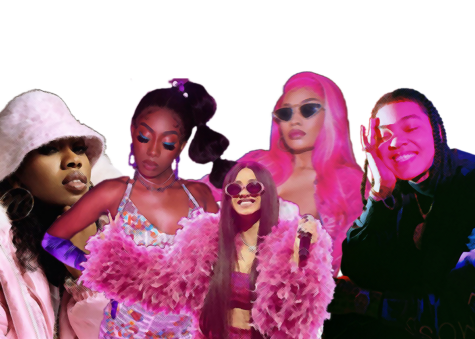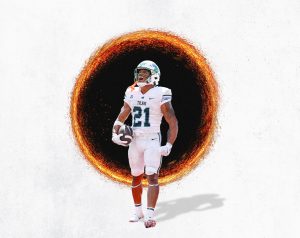Queens of rap take back crown
March 8, 2023

At age nine, I discovered Nicki Minaj. If I had to name the top three most pivotal moments of my life, then the moment I first heard a Minaj song would make it in that list. This may seem dramatic, but I cannot stress how crucial Minaj is to my music taste.
Considering my deep love for Minaj, it is no surprise that in recent years I’ve expanded my adoration to the larger genre of female rap. One of my most liked playlists on Spotify — my pride and joy — is my personal collection of female rap songs, appropriately titled “The Revised Feminist Agenda.” Since 2019, I have scoured the internet for the perfect additions to my master playlist and tried to include artists that don’t get nearly as much attention as Minaj.
Many women in the genre preceded Minaj and many have followed her. All the greats within the genre deserve to be held to the same esteem as not only Minaj but also other rappers, male or female.
Flo Milli, Doechii, Coi Leray and Rubi Rose are all featured on the playlist. All four made it onto the XXL Freshman Class, alongside rappers like Iann Dior, Pooh Shiesty and Cochise. The XXL Freshman Class is a particularly important milestone for up-and-coming rappers — although they’ve lacked gender representation until relatively recently. Bali Baby, Asian Doll, Queen Key, Saweetie and City Girls have yet to be featured in the Freshman Class, despite their success compared to their male counterparts.
The rise of female rap coincided with the rise of hip-hop itself. DJ Kool Herc, the founding father of hip-hop, began to host events in the Bronx, New York in the early 1970s. He soon hired Coke La Rock to MC for his events, who became the first rapper.
Sharon Green, also known as MC Sha-Rock, entered the hip-hop scene in the Bronx in 1976. Sha-Rock was a member of “The Funky 4+1,” the first hip-hop group to perform on television, appearing on Saturday Night Live in 1981. Green — “First Lady of Hip-Hop” — is widely known as the first female rapper.
Between 1976 and today, female rap has come a long way.
In the 80s, Salt-n-Pepa made history as the first female rap group, helping to push rap into the mainstream by the 90s. The 90s saw rappers like Queen Latifah, whose focus on female empowerment and Afrocentricity defined her career. Ms. Lauryn Hill was also instrumental in 90s female rap, employing a similar Afrocentric perspective through her lyrical prowess.
The “Rap Diva” image didn’t make its way into the mainstream until Lil’ Kim. Though female rappers had embraced their sexuality prior to Lil’ Kim, she took it to the next level. While rivaling rapper Foxy Brown, the two artists redefined the female rap genre by roping in drama and sex as nearly integral aspects of their work.
Female rap is such a broad category that accurately judging the genre as a whole is nearly impossible. Just as male rappers vary wildly in style, skill and lyrics, female rappers differ in the same manner. Consider the difference between Young M.A. and Cardi B: their sounds, lyrics, melodies and beats fall on two opposite ends of a spectrum. While Young M.A.’s style falls more in line with other contemporary male rappers, Cardi B’s work is more reminiscent of her female rap predecessors.
What is different, though, about male and female rap is not in the content itself but in the way people criticize the two.
Critiques of female rap often center around sexualization. The media uproar following the release of Cardi B and Megan Thee Stallion’s “W.A.P.” is a telling example of the misogyny that surrounds female rap. Rapper CeeLo Green criticized rappers like Cardi B and Megan Thee Stallion for their “salacious gesturing” to reach the top of the charts. There are overtly sexual aspects to female rap, but it is reductionist to label all of female rap as such.
Female rap may not be for everyone. But, I find that the way people justify their dislike for female rap often stems from the intersection of racism and sexism. There is a glaring discomfort with women’s sexuality, and female rap is often representative of unapologetic sexual expression because sex sells — especially in an industry that so often objectifies women.
Is it such a crime for a woman to want to shake what her mother gave her or to talk about it in her music? It seems that many turn a blind eye to the men who blatantly objectify women and normalize imagery of gendered violence in their music. A 2001 study that analyzed 490 rap songs from 1987 to 1993 found that 22% of the songs had lyrics featuring violence towards women in the forms of assault, rape and murder.
Some academics consider rap to be a force that subordinates Black women specifically — that certain lyrics may provide rationalizations to engage in violence towards Black women. Of course, not all mainstream rap subscribes to these problematic ideals. But, when talking about female rappers who sexualize themselves or sexualize men, maybe we should consider the ways in which female rappers are responding to an already-established norm.
Is it truly the end of the world if a woman starts to talk about men in the same vein that men have talked about women for ages? Will the Lord strike me down in fiery wrath when I press shuffle on my Spotify playlist?
The way that female rap has been demonized, downplayed and delegitimized even by members of the rap community itself only further fuels my passion for the genre. If a woman has the ability to create so much discomfort by simply existing within a male-dominated genre, then I will fully support it. I will continue to listen and take in the colorful lyricism, unparalleled creativity and boastful voices. Nothing is more inspiring than a woman so eloquently doing whatever she wants in spite of all the ignorant squabble.









Leave a Comment